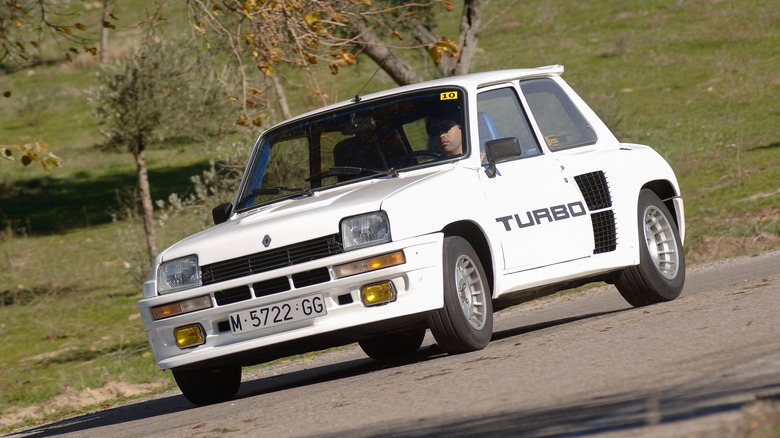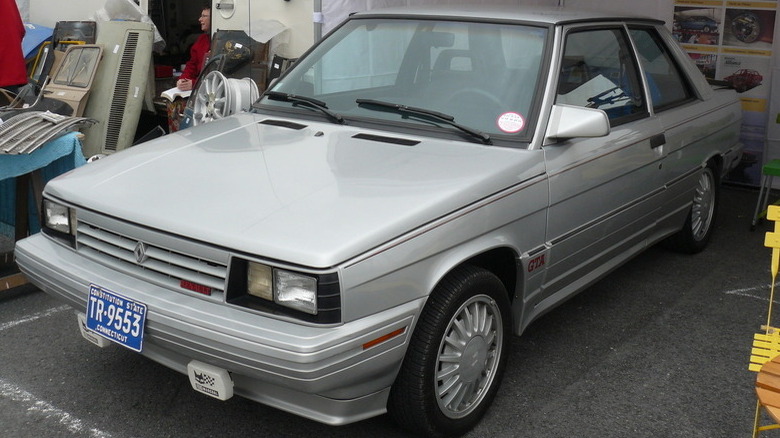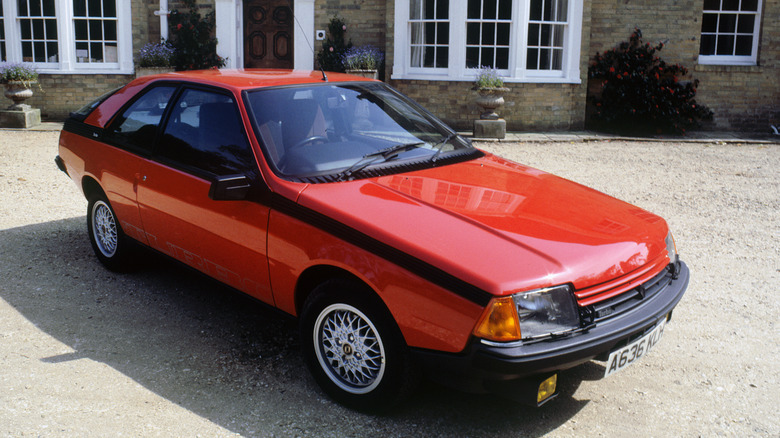The Five Best Renault Cars Ever Sold In America
Renault has a history as one of France's largest automakers, but its presence in America has been spotty. Before World War II, you might find the occasional privately-imported Renault. The postwar years brought the economy-minded Dauphine to America to compete against the ever-popular Volkswagen.
As the '60s and '70s wore on, competition was fierce in the compact car market due to the oil crisis and the emerging Japanese auto industry. The fourth-largest American automaker, American Motors (AMC), had no fuel-efficient subcompact cars to sell, while Renault had no dealership network. As AMC faltered, Renault — backed by the French government — stepped in to guarantee AMC's loans and eventually purchased a significant portion of the company.
This led to AMC manufacturing and selling popular Renault subcompact cars (with the Renault badge) in America. This ended in 1987, however, when Chrysler purchased AMC from Renault, mainly to acquire Jeep. The Renault brand disappeared from these shores, though a few models were released with Chrysler badges until the early 2000s.
While the new millennium has yet to yield the iconic Renault diamond badge in the U.S., its presence is felt. In 1999, Renault allied with Nissan. Ever since, several small Nissan cars share underpinnings with Renaults. Further, Renault's subsidiary Alpine is expected to debut a performance electric sports car that may be sold here.
So, while Francophile gearheads wait for the return of the Tricolore, let's consider the best Renaults in history to be sold in the U.S., in no particular order.
Renault LeCar
Through the decades, several British and European automakers named their models with simple numbering schemes, often relating to arcane government tax categories based on arithmetic formulas known as "Tax Horsepower." These figures had little to do with the actual horsepower produced by the engines but ultimately proved useful for comparing models from different manufacturers. In England, the Austin Seven was named for this theoretical tax horsepower number, and in France, the famous Citroen 2CV and Renault 4CV were similarly named — CV being short for "chevaux," horse in French.
The Renault 5 was the natural development of the popular Renault 4CV and the Renault 4. But American consumers had no context for the numbering scheme, and sales upon U.S. introduction in 1976 were lackluster.
A cheeky rebrand of the 5 as the LeCar in 1977 proved fruitful, as Renault played up the Gallic nature of the subcompact. In 1979, AMC began distributing Renault in the U.S., further helping sales.
The LeCar was an efficient subcompact with surprising room and good ride quality. A quirk of engineering showed up in the wheelbase, which was slightly longer on one side of the LeCar than the other. This was due to transversely-mounted torsion bars for the front suspension, as the bars would stretch across the car and had to be offset from each other. It was never a top seller but remained available in the U.S. until 1983.
[Image by Johnathan Kellenberg via Wikimedia Commons | Cropped and Scaled | CC BY 2.0]
Renault 5 Turbo
Rally racing has long been a genre of motorsport favored by automakers, as it takes real-world, usually street-legal cars and races them on public streets and in forests. It's often seen as a marketing tool, showing the buying public what the car they can buy might be able to do, given enough money and modifications.
As the 1970s supercar boom showed the incredible handling potential of mid-engined cars, Lancia offered the Stratos, a mid-engined rally car developed in conjunction with Ferrari. It proved hard to beat, but Renault saw an opportunity to use a different racing technology — turbocharging. Renault had been the pioneer of turbocharging in Formula 1 and decided to boost the performance of the Renault 5 by putting a turbocharged four-cylinder in the hatchback of their subcompact hatch.
Around 400 cars were initially built to homologate the Renault 5 Turbo for rallying, complete with lightweight aluminum body panels. A later Renault 5 Turbo 2 used more steel body panels instead, trading a bit of weight for a lower cost to the buyer.
The Renault 5 Turbo was never officially imported to the U.S., though a few grey-market importers brought them to the States for those enthusiasts looking to experience the greatest in Gallic rally performance.
Renault Alliance GTA
As the partnership between American Motors and Renault grew, Renault saw advantages in building cars for the U.S. market in North America due to the weak dollar of the early '80s. Fortunately, AMC had a plant in Kenosha, Wisconsin, available.
Renault had designed the two-door 9 sedan and 11 three-door hatchback for Europe, and these were redeveloped for American production as the Renault Alliance and Encore. These proved popular, inexpensive cars for a recovering American economy, and the Alliance won Motor Trend's Car of the Year award in 1983. AMC/Renault even sponsored entry-level, single-marque road racing series with the Alliance and Encore.
The compact car market moved swiftly, and what was popular in the early '80s was quickly outdated. In a last-gasp effort to spur interest, AMC and Renault developed the Alliance GTA as a sportier version of the milquetoast Alliance. Sporting fiberglass ground effect bodywork, monochrome trim, alloy wheels, and a hotter 95 horsepower engine, the GTA was offered as a two-door sedan and a convertible for the 1987 model year.
Reviewers enjoyed the extra performance and street styling of the Alliance GTA. However, as Chrysler took ownership of AMC in 1987, the Renault brand was superfluous, and the Alliance/Encore factory in Kenosha was soon shut down.
[Image by Lebubu93 via Wikimedia Commons | Cropped and Scaled | CC BY-SA 3.0]
Renault Fuego Turbo
These days, there are precious few affordable sporty coupes available. Most performance cars tend to be high-powered, expensive, and out of the reach of everyday car buyers. Through the '70s and '80s, however, nearly every automaker built a compact, inexpensive coupe or hatchback based on a more pedestrian sedan in their lineup, giving shoppers the choice to go for a bit of extra style and fun for their tedious commutes.
For Renault, the Fuego was that hatchback. Pairing daring, aerodynamic styling with a comfortable, roomy interior, the Fuego was a reasonably popular choice among buyers looking for something different. An optional turbocharged engine gave the Fuego Turbo an extra kick, as 107 horsepower was impressive for the early '80s.
The wide glass hatchback of the Fuego gave drivers plenty of cargo room for such a small car. Another fun fact: The Renault Fuego was one of the first cars sold with a remote keyless entry. Ubiquitous today, the Renault PLIP remote locking/unlocking key fob allowed drivers to enter their locked car without putting a key in the door, which was space-age technology at the time.
Renault Dauphine
As Germany was liberated after World War II, Europeans and Americans marveled at the innovative Volkswagen built to get everyday Germans moving inexpensively. The rear-engined layout was especially revolutionary, giving maximum interior space to the occupants.
Renault initially offered the 4CV as a similar rear-engined people's car, but as the economy improved, they saw buyers looking for a better standard of driving. The Dauphine was a bit larger, with more power from the rear-mounted four-cylinder engine and more comfortable features.
Sales of the Dauphine began in the U.S. in the mid-'50s, and it proved popular for a time. It even outsold Volkswagen in some places. With just 32 horsepower, it wasn't fast, but it was inexpensive and reasonably reliable. However, it wasn't built for American roads and driving conditions and proved especially prone to rusting in areas that used salt on the roadways.
In the late 1960s, Renault advertising in the U.S. even apologized to consumers saying that they hadn't done their best with the Dauphine, asking Americans to give Renault another shot. Still, the Dauphine has several American fans to this day, enjoying the quirks that made it special.





